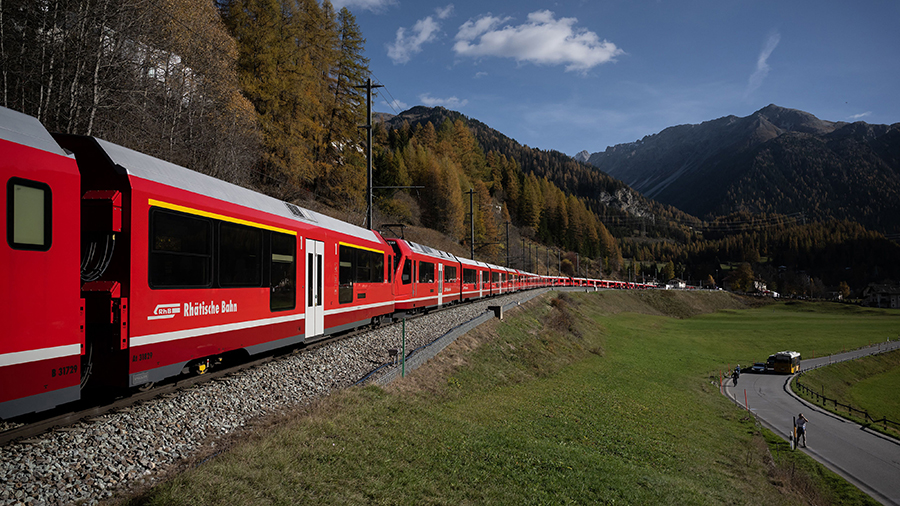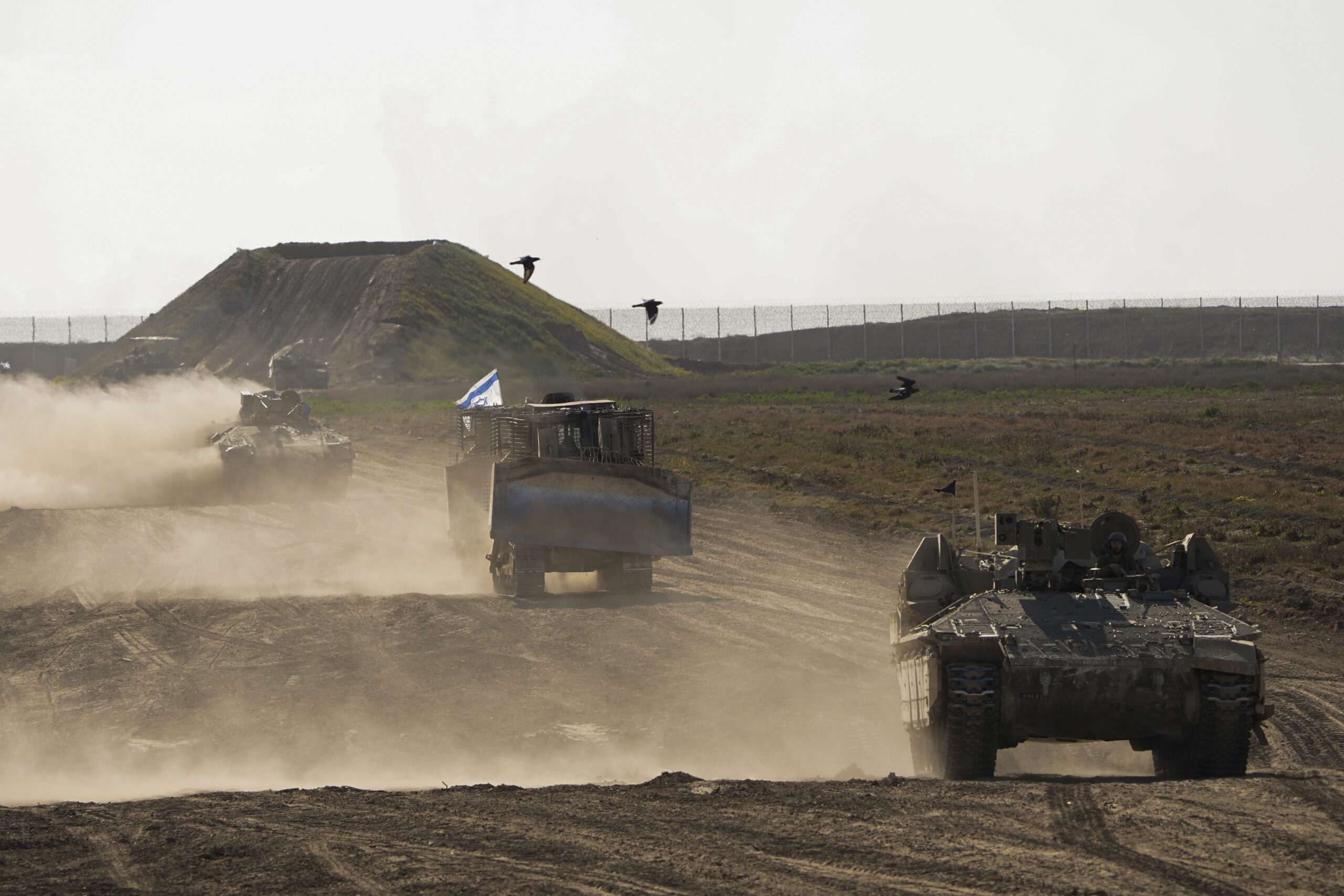Why Switzerland built a 2-kilometer-long train
Oct 30, 2022, 11:40 AM | Updated: 2:24 pm

A 1910-metre-long train with 100 cars passes by in Bergun on October 29, 2022, during a record attempt by the Rhaetian Railway (RhB) of the World's longest passenger train, to mark the Swiss railway operator's 175th anniversary. (FABRICE COFFRINI/AFP via Getty Images)
(FABRICE COFFRINI/AFP via Getty Images)
(CNN) — High in the Swiss Alps, St Moritz made its name as a place for pushing the boundaries of winter sport. By the time it hosted the second Winter Olympics Games in 1928 its reputation as a playground for wealthy adventurers was already well established.
On Saturday, the region continued its long tradition of expanding the limits of what is possible with an epic world record attempt — not on snow or ice, but on rails.
To celebrate the 175th anniversary of Switzerland’s first railway, the country’s rail industry came together to run the world’s longest-ever passenger train — 100 cars, 2,990 tonnes and almost two kilometres long.
This Saturday the Rhaetian Railway (Switzerland) ran the longest passenger train in the world on the UNESCO World Heritage route from the Albula Tunnel in Preda to the Landwasser Viaduct. The 1,906 meter long train was composed by 25 four-part multiple units pic.twitter.com/phZCvFGtlz
— Олександр Gavriluk (@ua_freeman) October 30, 2022
Formed of 25 new “Capricorn” electric trains the record-breaking 1,906-meter train took almost an hour to cover around 25 kilometers (about 15 miles) over the spectacular UNESCO World Heritage Albula Line from Preda to Alvaneu in eastern Switzerland.
Like the legendary Cresta Run toboggan track, the Albula Line is famous for its endless swooping curves and steep descents. A world-renowned masterpiece of civil engineering, the 62-kilometer line between Thusis and St Moritz took just five years to build despite requiring 55 bridges and 39 tunnels.
Prior to its completion in July 1904, visitors faced a risky 14-hour journey over rough tracks in horse-drawn carriages or sledges.
Centerpiece of the line is the 5,866-meter-long Albula Tunnel, which runs deep beneath the watershed between the Rhine and Danube rivers.
Spirals, soaring viaducts and tunnels
Following part of the route taken by the world-famous Glacier Express since 1930, the world record attempt took in the spectacular Landwasser Viaduct and the extraordinary spirals that secured the line’s international heritage status.
In less than 25 kilometers, the train plummeted from 1,788 meters above sea level at Preda to 999.3 meters at Alvaneu, using a succession of spirals, soaring viaducts and tunnels.
The record attempt was organized by the Rhaetische Bahn (Rhaetian Railway, or RhB), supported by Swiss train-builder Stadler, and is perhaps even more astonishing for taking place on a narrow gauge railway.
Unlike most Swiss and European railways, which use the “standard” gauge between the rails of 1.435 meters (4 feet 8.5 inches), RhB rails are just one meter apart.
Combine this with a route with notoriously tight curves, steep gradients, 22 tunnels and 48 bridges over deep valleys and the challenges become obvious.
Previous holders of the world’s longest passenger train record — Belgium and, before that, the Netherlands — used standard gauge railways through flat landscapes to their advantage.
However, preparations started months ahead of the RhB event, including test runs to ensure the unique train could be operated safely.
“We all know the Albula Line very well, every change of gradient, every incline,” said lead driver Andreas Kramer, 46, ahead of the big day. “It goes without saying that we’re going through the process again and again.”
He added: “We need to be 100% synchronized, every second. Everyone has to keep their speed and other systems under control at all times.”
An initial test run ended in failure before the train had even moved when it was discovered that the emergency brake system could not be activated and the seven drivers could not communicate with each other via radio or cellphone in the many tunnels.
Kramer, assisted by six other drivers and 21 technicians instead used a temporary field telephone system set up by the Swiss Civil Protection organization to maintain communications as the train ran at up to 35 km/h through countless tunnels and deep valleys.
Specially modified software and an intercom between the seven drivers allowed the 25 trains to work in harmony. Any mismatch in acceleration or deceleration during the journey would have exerted unacceptably high forces on tracks and power supplies, creating a major safety issue.
RhB Director Renato Fasciati said: “Switzerland is a railway country like no other. This year, we are celebrating 175 years of Swiss railways. With this world record attempt, RhB and its partners wanted to play their part in achieving a pioneering feat that had never been seen before.”
Party atmosphere
On the long descent, speed was controlled by regenerative braking, similar to that used on some electric cars, which fed current back into the 11,000-volt overhead power supply lines.
However, with so many trains in the same section of line, there was concern that they could feed too much current back into the system, overloading both trains and local power grids. To avoid this, the top speed of the train was limited to 35 km/h and software had to be modified to restrict the power being fed back.
Additional safety control cables also had to be fitted throughout the train to support the standard mechanical and pneumatic connections between trains.
On the big day, the RhB organized a railway festival at Bergün and 3,000 lucky ticket holders were able to witness the record attempt via a live TV feed while also enjoying local entertainment and gastronomy. Normal services through the Albula Tunnel to St Moritz and beyond were suspended for 12 hours.
Three satellite uplinks, 19 cameras in drones and helicopters, on the train and along the track filmed the train, providing a unique record of this once-in-a-lifetime event. This alone was a major challenge in a remote, mountainous region with limited mobile telecoms coverage.
A railway nation
For a small country with a mountainous landscape which, at first glance, seems unsuited to railways, Switzerland punches well above its weight in the industry.
Necessity has long made it a pioneer in electrical, mechanical and civil engineering and its technology and expertise are exported all over the world.
Engineering feats such as the Gotthard Base Tunnel, opened in 2016, continue a long tradition of expanding the boundaries of the possible.
With good reason, the Swiss are the world’s most enthusiastic rail users, traveling an average of 2,450 kilometers every year by train — a quarter of their overall annual total. In common with other European countries, mobility has exploded in recent decades — the average annual distance travelled by car and public transport has doubled in the last 50 years.
They traveled 19.7 billion passenger kilometers by rail in 2019, the last “normal” year before the Covid-19 pandemic. In 2021 this fell to 12.5 billion passenger kilometers but as Switzerland celebrates 175 years since its first railway opened between Zürich and Baden, ridership is well on the way back to pre-pandemic levels.
So high are the expectations of public transport users in Switzerland that even a small delay is a source of quiet dissatisfaction. And not without good reason; many journeys in and around Switzerland’s biggest cities are multi-modal, reliant on slick connections between trains, trams, buses and even boats at well-organized interchanges.
In 2021, Swiss Federal Railways (SBB) operated 11,260 trains carrying 880,000 passengers and 185,000 tonnes of freight per day on a 3,265 kilometer-long network with 804 stations.
Adding the 70-plus “private” standard and narrow gauge railways, many of which are also partly or fully in public ownership, takes that network to around 5,300 kilometers, the densest rail network in the world.
A heavily co-ordinated network integrates SBB’s trains with numerous other operators, extensive narrow gauge railways such as the Rhaetische Bahn (RhB), mountain cog railways, funiculars, post buses, cable cars, boats and more, providing dependable car-free access to every corner of the country (see www.swiss-pass.ch).
Decades of long-term investment have created a core network of intensively used main lines linking all the country’s major cities. Feeding into this are high-frequency S-Bahn (city rail) systems around the biggest cities plus regional and local railway lines, tramways and mountain railways, many of which provide a critical link to the outside world for rural and upland communities.
Despite massive investment over the last four decades, through long-term expansion programs such as “Bahn 2000.” Switzerland’s railways are becoming a victim of their own success. While SBB’s overall punctuality still looks impressive to outsiders, there is concern about deteriorating performance, rising costs and its ability to fund essential maintenance and major projects after the devastating financial losses of 2020-21.
Disruption is still comparatively rare on the SBB network, but reliability has decreased in recent years as a result of congestion, staff shortages and poor punctuality of trains arriving from neighboring countries.
Strategic position
Sitting at the heart of western Europe, between the industrial powerhouses of Germany, France and northern Italy, Switzerland also plays a key strategic role in the wider European economy — as it has since the Middle Ages.
For centuries, the Alps presented a formidable barrier to travelers and trade across this part of Europe but over the last two decades, billions of Swiss Francs have been invested to build the lengthy Gotthard and Loetschberg Base Tunnels deep under the Alps.
While other countries argue and dither over public transport spending, in June 2022 the Swiss Federal Council opened consultations on its next program of long-term rail investment. Perspektive Bahn 2050 is a detailed set of proposals with a clear focus on developing short and medium-distance passenger services to promote a shift away from cars.
Enhancement of the existing network to create extra capacity is to be prioritized over more major infrastructure projects. Transport Minister Simonetta Sommaruga says: “It’s not a question of saving a few minutes on a trunk route such as Zürich-Bern. Rail is already unbeatable on routes like that. It is rather about expansion where rail has been left behind.”
Expected to be passed into law by 2026, the plan’s objectives include increasing annual public transport usage from 26 billion passenger-kilometers to 38 billionn passenger-kilometers by 2050, increasing rail’s share of the passenger and freight markets “significantly” and ensuring that rail services are even more closely integrated with other transport modes to provide greater mobility for all.
Critics often cite Switzerland’s smaller population and relatively short distances when comparing it to countries such as the UK and Germany, claiming that it would be impossible to create similar integrated public transport networks in larger countries.
It’s true that the Swiss have built something ideally suited to their geography, culture and population density, but whatever the arguments elsewhere, the RhB’s incredible achievement on October 29 is a hugely impressive demonstration of Switzerland’s world-class capabilities in the field of railway technology.
Lead image credit: FABRICE COFFRINI/AFP via Getty Images
The-CNN-Wire™ & © 2022 Cable News Network, Inc., a Warner Bros. Discovery Company. All rights reserved.













